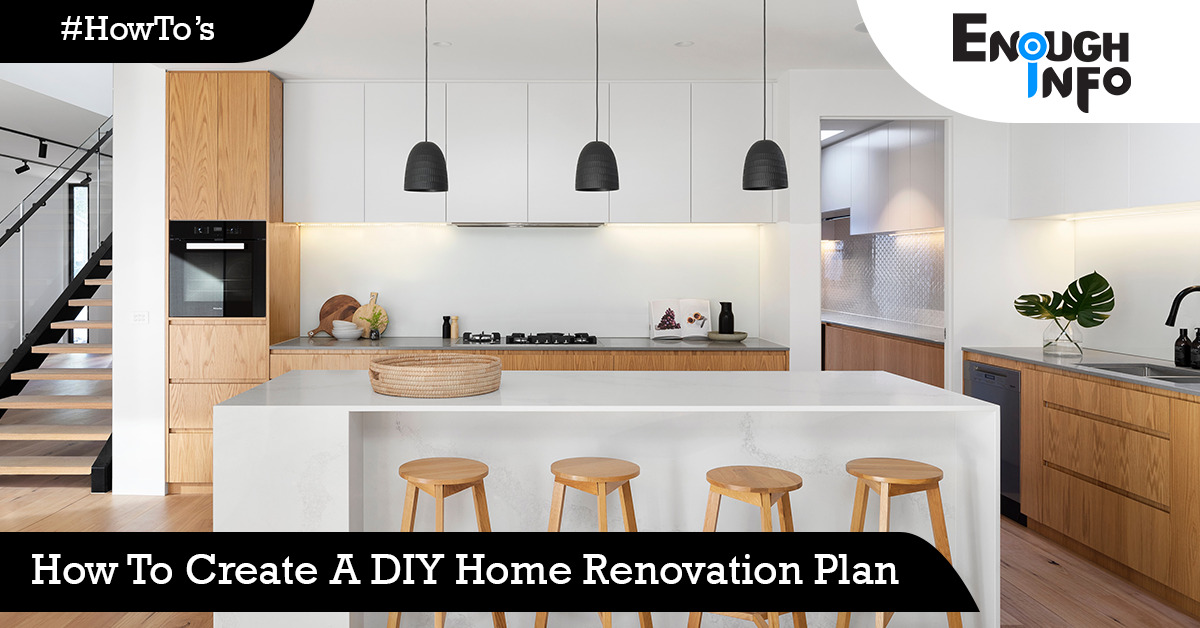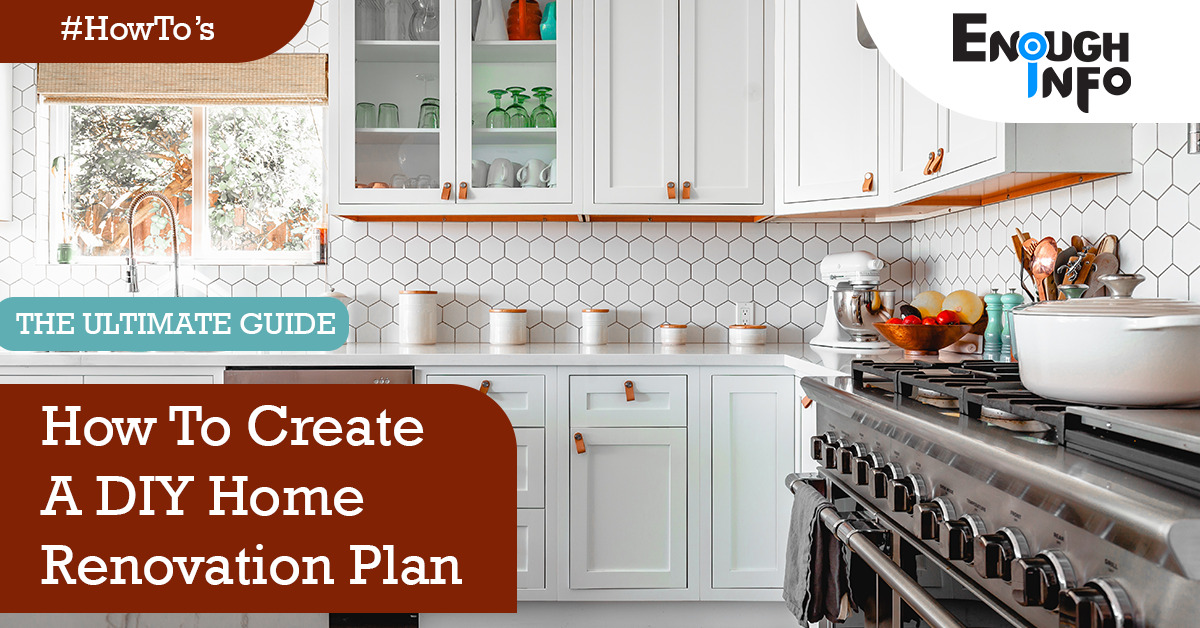How To Create A DIY Home Renovation Plan

How To Create A DIY Home Renovation Plan: Embarking on a home renovation project can be both exciting and daunting. Whether you’re planning to update a single room or tackle a complete home makeover, having a well-thought-out DIY home renovation plan is essential. EnoughInfo.com

Read Also: How To Do Basic Home Repairs
A renovation plan helps you stay organized, set clear goals, manage your budget effectively, and ensure that the project runs smoothly. A well-defined renovation plan allows you to set clear goals for your project. It helps you articulate your vision, identify specific outcomes, and prioritize what needs to be accomplished. Having a clear vision and goals in mind keeps you focused and motivated throughout the renovation process.
Creating a DIY home renovation plan is essential for staying organized, setting goals, managing your budget, and ensuring a successful outcome. It allows you to approach the project systematically, mitigate risks, and make informed decisions. A well-thought-out plan sets the foundation for a smooth and efficient renovation process, ultimately helping you achieve the desired results while minimizing stress and maximizing satisfaction.
FAQs & Answers on How To Create A DIY Home Renovation Plan
1. Can I tackle a DIY home renovation project without professional help?
It depends on the complexity of the project and your skill level. While many DIY home renovation projects can be successfully completed by homeowners, some tasks may require professional assistance. Be honest about your abilities and assess whether hiring professionals for certain aspects, such as electrical or plumbing work, would be safer and more efficient. How To Organize A Pantry(The Ultimate Guide)
2. How do I determine my renovation budget?
To determine your renovation budget, evaluate your finances and determine how much you can comfortably spend on the project. Consider factors such as your savings, available credit, and any potential financing options. Research the costs of materials and services to get an accurate estimation and allocate funds to different aspects of the project.
3. How can I ensure safety during a DIY renovation project?
Safety should always be a priority during a DIY renovation project. Familiarize yourself with safety protocols and guidelines before starting any work. Wear appropriate protective gear, use caution when handling tools and materials, and ensure proper ventilation in enclosed spaces. If unsure about safety procedures, consult experts or seek professional advice. How To Play The Drums For Beginners
4. What if I encounter unexpected challenges or setbacks during the renovation process?
It’s common to encounter unexpected challenges or setbacks during a renovation project. The key is to remain calm and approach them with a problem-solving mindset. Assess the situation, seek advice from professionals or online resources, and explore alternative solutions. Don’t be discouraged; challenges are opportunities to learn and grow.
5. How do I keep track of expenses during a DIY renovation project?
Maintaining a detailed record of expenses is essential during a DIY renovation project. Create a spreadsheet or use a budgeting app to track all the costs associated with materials, tools, permits, professional services, and any unexpected expenses. Regularly update the record to ensure you stay within your budget.
Read Also: How To Organize A Home Office
How to Create a DIY Home Renovation Plan: A Comprehensive Guide

In this comprehensive guide, we will walk you through the step-by-step process of creating a DIY home renovation plan that will help you bring your vision to life while avoiding common pitfalls along the way.
1. Assessing Your Needs and Setting Goals
Before diving into any renovation project, it’s crucial to assess your needs and set clear goals. Consider what you want to achieve with your renovation, whether it’s improving functionality, enhancing aesthetics, increasing energy efficiency, or all of the above. Take time to evaluate each space and determine the changes you’d like to make, considering factors like layout, storage, lighting, and overall design.
2. Defining Your Budget
Establishing a realistic budget is vital to ensure your DIY home renovation project stays on track financially. Determine how much you can comfortably spend and allocate funds to different aspects of the project, such as materials, tools, labor (if needed), and contingency expenses. Research the costs of materials and services to get an accurate estimation, and be prepared to make adjustments along the way as unforeseen expenses may arise.
3. Research and Inspiration Gathering
Take the time to research and gather inspiration for your renovation project. Explore home design magazines, websites, and social media platforms, and visit local home improvement stores to gather ideas and understand current trends. Create a mood board or a digital folder to collect images, colors, textures, and styles that resonate with your vision. This research phase will help you define your aesthetic preferences and make informed decisions during the renovation process. How To Make A Vegetarian Meal(The Ultimate Guide)
4. Prioritizing Renovation Projects
If you have multiple renovation projects in mind, prioritize them based on urgency, importance, and budget constraints. Determine which areas require immediate attention and which can be tackled later. By prioritizing, you can focus your efforts and resources on the most critical projects and ensure that they are completed before moving on to others.
Read Also: How To Create A DIY Home Decor
5. Creating a Timeline
Developing a timeline is essential for keeping your renovation project on schedule. Break down the overall project into smaller phases and set target dates for each phase. Consider factors such as the availability of resources, your personal schedule, and any upcoming events or commitments that may affect the renovation timeline. Be realistic with your timeline and allow for some flexibility to accommodate unforeseen delays or adjustments that may arise during the renovation process. How To Style Curly Hair (The Ultimate Guide)
6. Obtaining Permits and Permissions
Before starting any major renovation work, check if you need permits or permissions from your local authorities or homeowner’s association. Depending on the scope of your project, permits may be required for structural changes, electrical work, plumbing, or other significant modifications. Research the necessary permits and follow the application process to ensure compliance with local regulations and avoid potential legal issues in the future.
7. Gathering Tools and Materials
Once you have a clear understanding of your renovation plan, identify the tools and materials you’ll need for the project. Make a comprehensive list and gather all the necessary tools, equipment, and supplies. Consider borrowing or renting specialized tools if you don’t already own them. Purchase materials in advance to avoid delays and ensure they are readily available when needed.
8. Hiring Professionals
While this guide focuses on a DIY home renovation plan, it’s important to acknowledge that some tasks may require professional assistance. If you lack the skills, experience, or confidence to handle certain aspects of the project, consider hiring qualified professionals such as electricians, plumbers, or contractors. Research and gather recommendations, request quotes, and ensure they have the necessary licenses and insurance before hiring anyone.
9. Safety Precautions
Safety should always be a top priority during a DIY renovation project. Before starting any work, familiarize yourself with safety protocols and guidelines. Wear appropriate protective gear such as goggles, gloves, and masks when working with hazardous materials or tools. Use caution when handling heavy objects and ensure proper ventilation in enclosed spaces. Keep a first aid kit on hand and know the location of emergency exits and shut-off valves.
Read Also: How To Tell Your Lawn Needs Lime
10. Creating a Renovation Schedule
With your timeline established, create a detailed renovation schedule that outlines the tasks to be completed during each phase. Break down the work into manageable chunks and assign realistic timeframes for each task. Consider factors such as the complexity of the task, availability of help, and potential disruptions. A well-organized schedule will help you stay focused and accountable throughout the renovation process.
11. Breaking Down Tasks
To avoid feeling overwhelmed, break down larger tasks into smaller, actionable steps. This approach makes the renovation process more manageable and allows you to track progress effectively. Create a task list for each phase and prioritize the tasks within each list. As you complete each task, check it off the list, providing a sense of accomplishment and motivation to move forward. How To Play The Harmonica For Beginners
12. Tracking Progress and Adjustments
As you progress through your DIY home renovation plan, keep track of your accomplishments and any adjustments made along the way. Maintain a journal or spreadsheet to record completed tasks, expenses, and any changes or challenges encountered. This record will serve as a valuable reference and help you stay organized, especially if the renovation project spans an extended period. How To Make Homemade Salsa
13. Dealing with Challenges
During a renovation project, challenges are inevitable. It’s essential to stay calm and approach them with a problem-solving mindset. If you encounter unexpected issues or setbacks, take the time to assess the situation and explore possible solutions. Seek advice from professionals, consult online resources or forums, or consider hiring experts to address complex problems. Remember that challenges are opportunities to learn and grow, and with determination, you can overcome them.
14. Finishing Touches and Clean-Up
As you near the completion of your DIY home renovation project, focus on the finishing touches that will bring your vision to life. Install fixtures, apply final coats of paint, hang artwork, and add decorative elements to enhance the aesthetics of the space. Take pride in the details, as they can make a significant difference in the overall outcome of your renovation. How To Clean A Clogged Drain
Once all the renovation work is finished, dedicate time to thoroughly clean the space. Remove dust, debris, and construction materials. Wipe down surfaces, vacuum or mop the floors, and ensure that everything is tidy and presentable. This final step will help you appreciate and enjoy the results of your hard work.
15. Celebrating Your Accomplishments
Completing a DIY home renovation project is a significant achievement. Take a moment to appreciate the transformation you’ve made and celebrate your hard work and dedication. Invite friends and family to admire the newly renovated space and share in your sense of accomplishment. Reflect on the lessons learned, the skills acquired, and the satisfaction of turning your vision into reality.
Read Also: How To Make Homemade Natural Cleaning Products
Conclusion
Creating a DIY home renovation plan is a crucial step towards successfully transforming your living space. By assessing your needs, defining your budget, gathering inspiration, and breaking down tasks, you can navigate the renovation process with confidence and efficiency. Remember to prioritize safety, seek professional help when needed, and adapt to challenges along the way. With careful planning, organization, and determination, you can create a DIY home renovation plan that allows you to achieve your desired results and create a space that reflects your personal style and functionality.
Recommended;
How to create a DIY garden trellis
How To Do Basic Car Painting (All You Need To Know)
14 Cheap Ways to Block a Neighbors View (2023 Guide)




